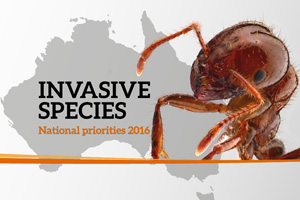
Invasive species in Australia – 2016 election priorities
We have identified seven key areas for reform as part of our 2016 national priorities.

We have identified seven key areas for reform as part of our 2016 national priorities.
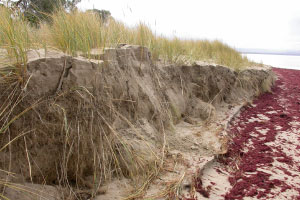
Guest author, Dane Panetta, considers the subject of weed eradication based on his paper just published in the international journal Weed Research.

A virulent rust attack decimating native plants and governments abandoning environmental biosecurity are just two frightening scenarios envisaged by a new CSIRO report.
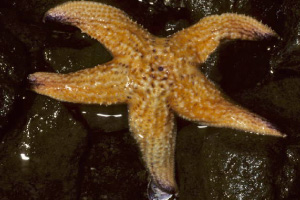
The federal Budget 2014-15 delivers nothing of much note for environmental biosecurity, although more than $3 million over four years has been allocated for a review of marine pests.
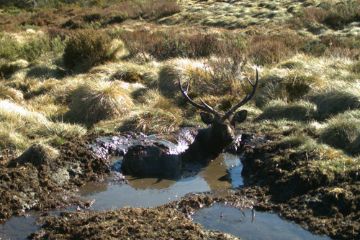
New report from Frontier Economics warns not controlling the impacts of feral deer in Victoria could cost the community $2.2 billion.
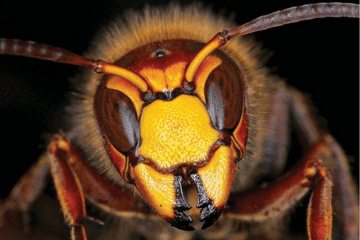
This document outlines initiatives and policies for the next Australian Government to keep our native wildlife safe from new and established invasive species.

For the first time ever the native vegetation of Norfolk Island has been mapped, both as it exists now and before European arrival in 1750.

A report into the ethical considerations of using 1080 to control feral animals has found the conservation benefits necessitate its use until an alternative is available.

April 2020
An investigation into insects overseas that represent the greatest risks for Australia and how they could arrive in this country.

The Invasive Species Council supports the development of an interim national priority list of exotic environmental pests and diseases as the first step in developing a more comprehensive list of environmental biosecurity risks for Australia.

June 2019
Our Risks and Pathways Project set out to identify insect species from other countries that, if they ever reach Australia, have the potential to cause great harm to our natural environment.

Submission to the Australian Senate inquiry into the impacts of feral deer, pigs and goats in Australia, November 2018.

October 2017
This report presents the result of surveys conducted by Ecology Australia for the smooth newt during the spring of 2016 in south-east Melbourne to help determine the ongoing persistence and spread of the species.

Seven national priorities for invasive species reform that deliver long-term cost savings, stem biodiversity losses and enhance agricultural productivity.
A submission to the Australian government draft feral cat threat abatement plan that seeks improved nationally coordinated action and funding to reduce the environmental impact from feral cats. Submitted July 2015.

We have identified seven key areas for reform as part of our 2016 national priorities.

Guest author, Dane Panetta, considers the subject of weed eradication based on his paper just published in the international journal Weed Research.

A virulent rust attack decimating native plants and governments abandoning environmental biosecurity are just two frightening scenarios envisaged by a new CSIRO report.

The federal Budget 2014-15 delivers nothing of much note for environmental biosecurity, although more than $3 million over four years has been allocated for a review of marine pests.

New report from Frontier Economics warns not controlling the impacts of feral deer in Victoria could cost the community $2.2 billion.

This document outlines initiatives and policies for the next Australian Government to keep our native wildlife safe from new and established invasive species.

For the first time ever the native vegetation of Norfolk Island has been mapped, both as it exists now and before European arrival in 1750.

A report into the ethical considerations of using 1080 to control feral animals has found the conservation benefits necessitate its use until an alternative is available.

April 2020
An investigation into insects overseas that represent the greatest risks for Australia and how they could arrive in this country.

The Invasive Species Council supports the development of an interim national priority list of exotic environmental pests and diseases as the first step in developing a more comprehensive list of environmental biosecurity risks for Australia.

June 2019
Our Risks and Pathways Project set out to identify insect species from other countries that, if they ever reach Australia, have the potential to cause great harm to our natural environment.

Submission to the Australian Senate inquiry into the impacts of feral deer, pigs and goats in Australia, November 2018.

October 2017
This report presents the result of surveys conducted by Ecology Australia for the smooth newt during the spring of 2016 in south-east Melbourne to help determine the ongoing persistence and spread of the species.

Seven national priorities for invasive species reform that deliver long-term cost savings, stem biodiversity losses and enhance agricultural productivity.
A submission to the Australian government draft feral cat threat abatement plan that seeks improved nationally coordinated action and funding to reduce the environmental impact from feral cats. Submitted July 2015.

We have identified seven key areas for reform as part of our 2016 national priorities.

Guest author, Dane Panetta, considers the subject of weed eradication based on his paper just published in the international journal Weed Research.

A virulent rust attack decimating native plants and governments abandoning environmental biosecurity are just two frightening scenarios envisaged by a new CSIRO report.

The federal Budget 2014-15 delivers nothing of much note for environmental biosecurity, although more than $3 million over four years has been allocated for a review of marine pests.

New report from Frontier Economics warns not controlling the impacts of feral deer in Victoria could cost the community $2.2 billion.

This document outlines initiatives and policies for the next Australian Government to keep our native wildlife safe from new and established invasive species.

For the first time ever the native vegetation of Norfolk Island has been mapped, both as it exists now and before European arrival in 1750.

A report into the ethical considerations of using 1080 to control feral animals has found the conservation benefits necessitate its use until an alternative is available.

April 2020
An investigation into insects overseas that represent the greatest risks for Australia and how they could arrive in this country.

The Invasive Species Council supports the development of an interim national priority list of exotic environmental pests and diseases as the first step in developing a more comprehensive list of environmental biosecurity risks for Australia.

June 2019
Our Risks and Pathways Project set out to identify insect species from other countries that, if they ever reach Australia, have the potential to cause great harm to our natural environment.

Submission to the Australian Senate inquiry into the impacts of feral deer, pigs and goats in Australia, November 2018.

October 2017
This report presents the result of surveys conducted by Ecology Australia for the smooth newt during the spring of 2016 in south-east Melbourne to help determine the ongoing persistence and spread of the species.

Seven national priorities for invasive species reform that deliver long-term cost savings, stem biodiversity losses and enhance agricultural productivity.
A submission to the Australian government draft feral cat threat abatement plan that seeks improved nationally coordinated action and funding to reduce the environmental impact from feral cats. Submitted July 2015.
Get our blog the Feral Herald delivered to your inbox.
Our protected areas are being trashed, trampled, choked and polluted by an onslaught of invaders. Invasive species are already the overwhelming driver of our animal extinction rate, and are expected to cause 75 of the next 100 extinctions.
But you can help to turn this around and create a wildlife revival in Australia.
From numbats to night parrots, a tax-deductible donation today can help defend our wildlife against the threat of invasive weeds, predators, and diseases.
As the only national advocacy environment group dedicated to stopping this mega threat, your gift will make a big difference.
A silent crisis is unfolding across Australia. Every year, billions of native animals are hunted and killed by cats and foxes. Fire ants continue to spread and threaten human health. And the deadly strain of bird flu looms on the horizon. Your donation today will be used to put the invasive species threat in the media, make invasive species a government priority, ensure governments take rapid action to protect nature and our remarkable native wildlife from invasives-led extinction, death and destruction.
If you are having trouble submitting a form, please read this guide.
Please fill out the following form and one of our team will be in contact to assist as soon as possible. Please make sure to include any helpful information, such as the device you were using (computer, tablet or mobile phone) and if known, your browser (Mozilla Firefox, Chrome, Safari etc)
"*" indicates required fields
Dear Project Team,
[YOUR PERSONALISED MESSAGE WILL APPEAR HERE.]
I support the amendment to the Kosciuszko National Park Wild Horse Heritage Management Plan to allow our incredible National Parks staff to use aerial shooting as one method to rapidly reduce feral horse numbers. I want to see feral horse numbers urgently reduced in order to save the national park and our native wildlife that live there.
The current approach is not solving the problem. Feral horse numbers have rapidly increased in Kosciuszko National Park to around 18,000, a 30% jump in just the past 2 years. With the population so high, thousands of feral horses need to be removed annually to reduce numbers and stop our National Park becoming a horse paddock. Aerial shooting, undertaken humanely and safely by professionals using standard protocols, is the only way this can happen.
The government’s own management plan for feral horses states that ‘if undertaken in accordance with best practice, aerial shooting can have the lowest negative animal welfare impacts of all lethal control methods’.
This humane and effective practice is already used across Australia to manage hundreds of thousands of feral animals like horses, deer, pigs, and goats.
Trapping and rehoming of feral horses has been used in Kosciuszko National Park for well over a decade but has consistently failed to reduce the population, has delayed meaningful action and is expensive. There are too many feral horses in the Alps and not enough demand for rehoming for it to be relied upon for the reduction of the population.
Fertility control as a management tool is only effective for a small, geographically isolated, and accessible population of feral horses where the management outcome sought is to maintain the population at its current size. It is not a viable option to reduce the large and growing feral horse population in the vast and rugged terrain of Kosciuszko National Park.
Feral horses are trashing and trampling our sensitive alpine ecosystems and streams, causing the decline and extinction of native animals. The federal government’s Threatened Species Scientific Committee has stated that feral horses ‘may be the crucial factor that causes final extinction’ for 12 alpine species.
I recognise the sad reality that urgent and humane measures are necessary to urgently remove the horses or they will destroy the Snowies and the native wildlife that call the mountains home. I support a healthy national park where native species like the Corroboree Frog and Mountain Pygmy Possum can thrive.
Dear Project Team,
[YOUR PERSONALISED MESSAGE WILL APPEAR HERE.]
I support the amendment to the Kosciuszko National Park Wild Horse Heritage Management Plan to allow our incredible National Parks staff to use aerial shooting as one method to rapidly reduce feral horse numbers. I want to see feral horse numbers urgently reduced in order to save the national park and our native wildlife that live there.
The current approach is not solving the problem. Feral horse numbers have rapidly increased in Kosciuszko National Park to around 18,000, a 30% jump in just the past 2 years. With the population so high, thousands of feral horses need to be removed annually to reduce numbers and stop our National Park becoming a horse paddock. Aerial shooting, undertaken humanely and safely by professionals using standard protocols, is the only way this can happen.
The government’s own management plan for feral horses states that ‘if undertaken in accordance with best practice, aerial shooting can have the lowest negative animal welfare impacts of all lethal control methods’.
This humane and effective practice is already used across Australia to manage hundreds of thousands of feral animals like horses, deer, pigs, and goats.
Trapping and rehoming of feral horses has been used in Kosciuszko National Park for well over a decade but has consistently failed to reduce the population, has delayed meaningful action and is expensive. There are too many feral horses in the Alps and not enough demand for rehoming for it to be relied upon for the reduction of the population.
Fertility control as a management tool is only effective for a small, geographically isolated, and accessible population of feral horses where the management outcome sought is to maintain the population at its current size. It is not a viable option to reduce the large and growing feral horse population in the vast and rugged terrain of Kosciuszko National Park.
Feral horses are trashing and trampling our sensitive alpine ecosystems and streams, causing the decline and extinction of native animals. The federal government’s Threatened Species Scientific Committee has stated that feral horses ‘may be the crucial factor that causes final extinction’ for 12 alpine species.
I recognise the sad reality that urgent and humane measures are necessary to urgently remove the horses or they will destroy the Snowies and the native wildlife that call the mountains home. I support a healthy national park where native species like the Corroboree Frog and Mountain Pygmy Possum can thrive.